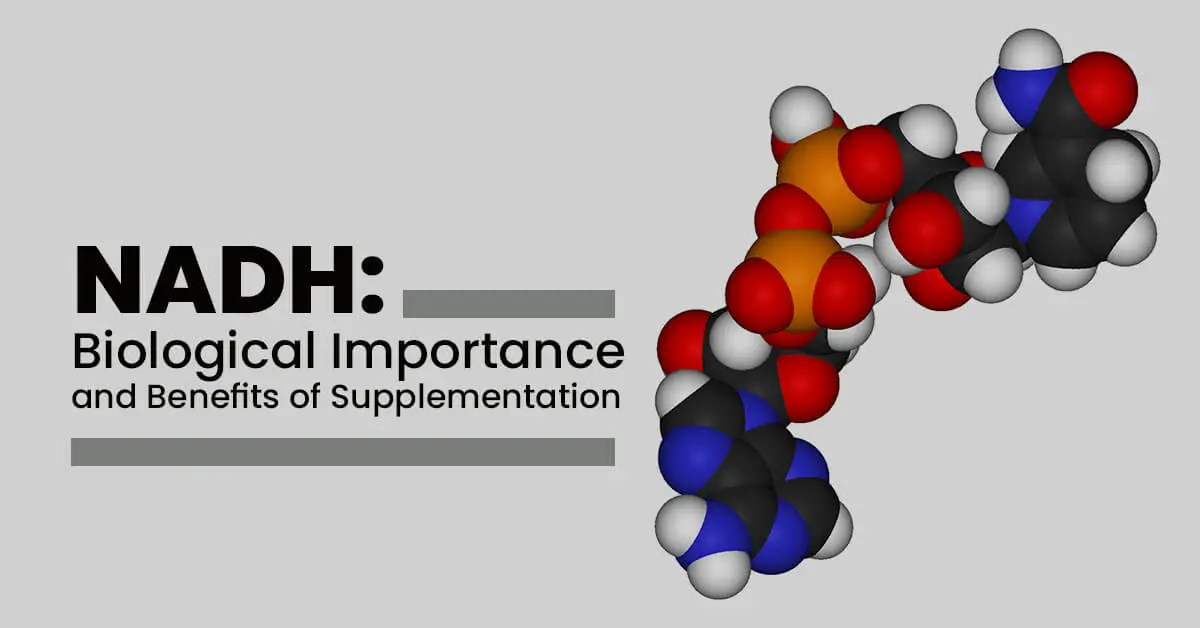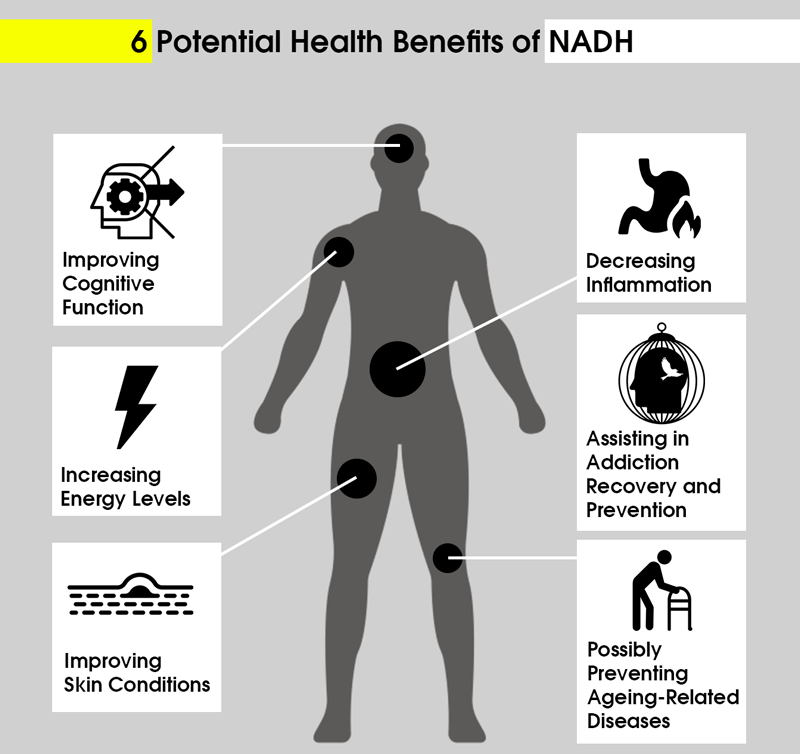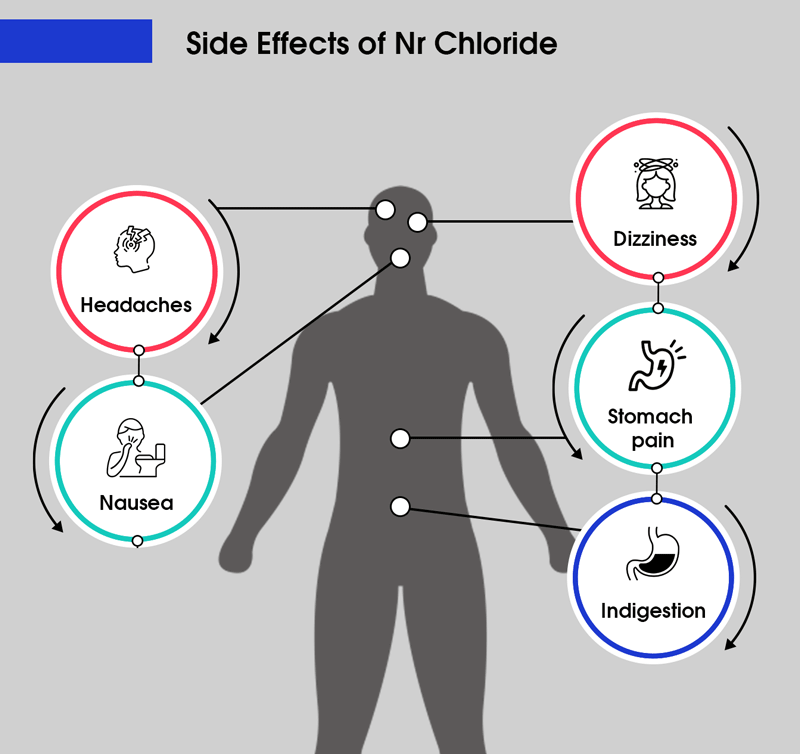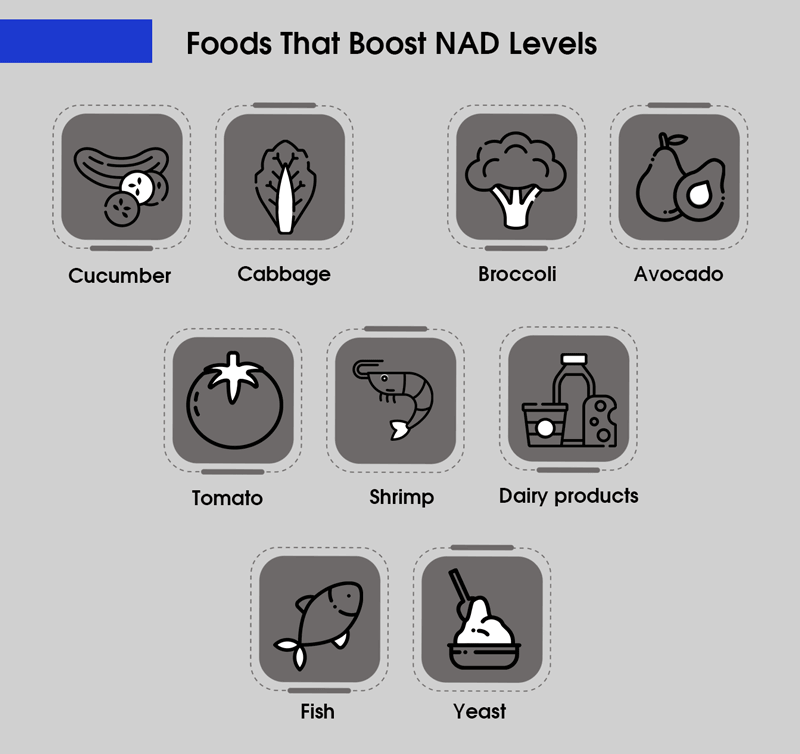NADH is an essential component of our bodies’ energy production and overall health maintenance. Unfortunately, the NADH concentrations in our bodies often decline as we age, leaving us feeling tired, restless, and with constant brain fog.
Thankfully there are many NADH supplements on the market, and it is even possible to boost NAD levels naturally.
This article delves into the uses and importance of NADH while providing an overview of the many things that can help boost their levels and metaphorically turn back the hands of time.
Key Takeaways
- Nicotinamide adenine dinucleotide hydride is a vital coenzyme required for our cells’ energy production which takes place in the cells’ cytosol and mitochondria.
- NADH is formed from various reactions during cellular metabolism, including glycolysis, which produces ATP from ADP and phosphate, and the waste product carbon dioxide in the end.
- The compound is necessary for ATP production through the action of the electron transport chain, which allows for the binding of another phosphate molecule to ADP.
- NADH provides various health benefits, including improving cognitive function and skin health, decreasing inflammation, and assisting in easing withdrawal symptoms and cravings caused by drug addiction treatment.
- NAD supplements like Tru Niagen can help boost your NAD levels to increase your energy levels and promote healthy aging.
- NAD supplements usually don’t cause any adverse side effects, even when taken at high doses.
- There are natural ways to boost NAD levels, like eating specific foods, following a low-calorie diet, and getting enough sleep.
What Is NADH
Nicotinamide adenine dinucleotide hydride, also called coenzyme 1, is a naturally occurring chemical that plays an essential role in the three stages of cellular respiration in cells: glycolysis, the citric acid reaction pathway, and oxidative phosphorylation, all of which produces ATP from adenosine diphosphate and phosphate, and carbon dioxide. This process requires glucose and oxygen, as well as various enzyme complexes, to be successful and takes place in the cytoplasm and mitochondrial matrix of the cell.
Understanding the importance of NADH requires having some knowledge of NAD (NADH and NAD+) as a whole. These two chemicals are interchangeable during respiration as certain reactions turn NAD+ into an NADH molecule and vice versa.
NAD plays a role in various vital processes in living organisms, including [1]:
- Energy metabolism (including pathways called glycolysis, phosphorylation, and the TCA cycle) in the cytoplasm and mitochondria
- Functions of the mitochondria of cells
- Calcium level maintenance
- Antioxidative processes
- Gene expression
- Immune function
- A substrate in reactions controlled by an enzyme group called sirtuins
- Aging
- Cell death
- Neurotransmitter production pathways
Health Benefits of NADH
Many people experiencing the effects of aging or chronic fatigue turn to NADH supplements for various benefits, including:
Increasing Energy Levels
As a result of the essential role NAD plays in cellular metabolism, using an NADH supplement along with coenzyme Q10 can help combat the effects of chronic fatigue syndrome (CFS) by elevating your overall energy levels and reducing feelings of anxiety associated with poor sleep and other CFS symptoms [2, 3].
NAD does this by assisting your cells’ conversion and breakdown of glucose into energy through the production of adenosine triphosphate (ATP) from adenosine diphosphate (ADP) and a phosphate group during respiration pathways [4].
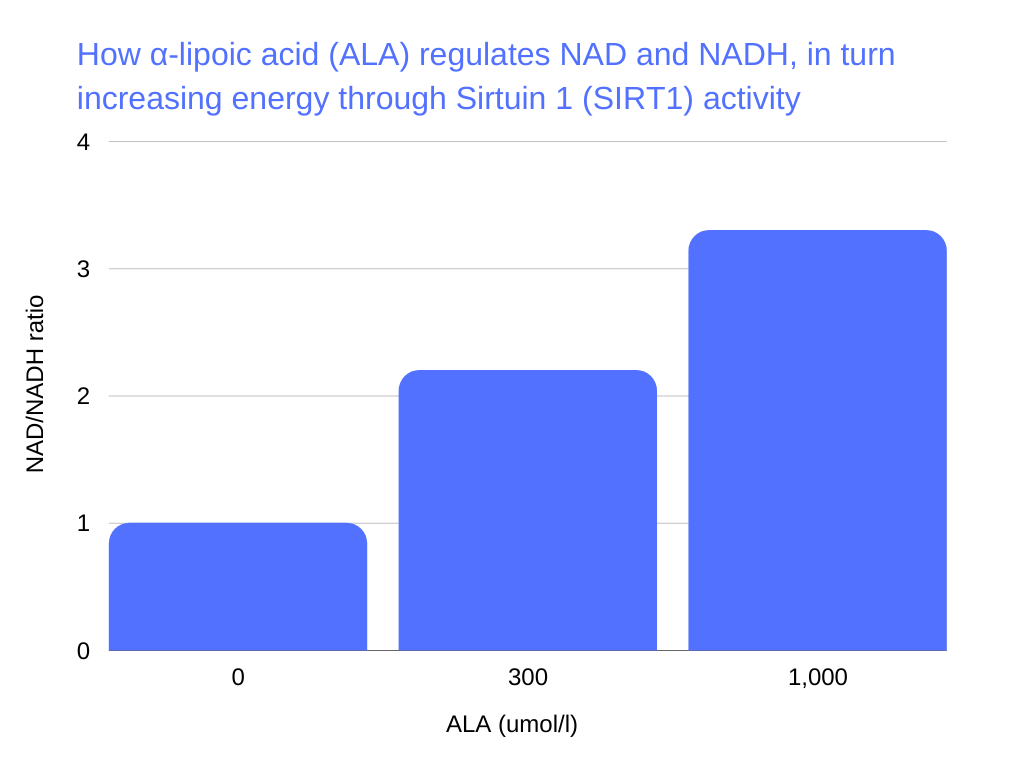
Source: https://www.researchgate.net/figure/ALA-increases-SIRT1-activity-and-production-by-modulating-the-NAD-NADH_fig1_223136541
Improving Cognitive Function
NAD plays a significant role in the maintenance of healthy cognitive function. This is because of the need for NAD to:
- Allow enzymes (specific proteins) involved in neuronal stress resistance to function as needed [5]
- Play an important role in neurotransmission, learning, and memory [6]
- Mediate brain aging and tissue or damage to cells during brain disease [7]
Improving Skin Conditions
NAD (NADH and NAD+) can improve specific skin conditions like photoaging and actinic keratosis as the substance plays an essential role in DNA repair, which is necessary for counteracting skin damage [8].
Decreasing Inflammation
NAD supplementation can help decrease the levels of inflammatory groups of cytokines in your body, producing an anti-inflammatory effect, although the extent of these benefits is not yet sufficiently researched [9].
Assisting in Addiction Recovery and Prevention
NAD supplements may assist in restoring the health processes that reduce the cravings and withdrawal effects in individuals recovering from a substance abuse disorder [10].
Possibly Preventing Ageing-Related Diseases
NADH and NAD+ may play a role in reducing the possibility of developing age-related illnesses like cancer and neurodegeneration [11].
NADH Possible Impact on Mental-Related Conditions
NADH has been recommended as a treatment for a variety of mental health and brain-related diseases.
Most of these recommendations are based on the role of sirtuins, which are NAD-dependent enzymes, or proteins. Sirtuins play an essential part in cognitive and emotional processing, and a deficiency of sirtuin proteins could result in mood disorders and brain illnesses [12].
There is some argument that NAD can help combat these disorders, including depression, anxiety, Parkinson’s, and Alzheimer’s [13].
This effect is achieved through improved cognitive functioning and increased energy levels [14]. Even though many people assume these benefits can help reverse the diseases, there is no significant scientific evidence yet, although the effect of NADH on the brain does seem promising [15, 16].
How Does NADH Work
The primary function of NADH is in the cellular respiration of glucose, during which the cells in your body use glucose as a substrate along with oxygen to produce adenosine triphosphate (ATP) and carbon dioxide. This process includes three reaction steps controlled by enzymes, or specialized proteins: glycolysis, the TCA cycle, and phosphorylation, which take place in the cytosol or mitochondrial matrix in a cell.
ATP is the energy carrier molecule of the body and without it, we would not survive.
NAD can exist in two forms, NADH itself and NAD+. NAD+ is the oxidized form of NADH and can accept an electron from other compounds or chemicals. NADH and NAD+ are sometimes referred to collectively as NAD.
NAD is involved in cellular respiration during all three steps, each of which is described below:
- Glycolysis: Glycolysis is enzyme-controlled and occurs in the cell’s cytosol. It involves glucose undergoing several chemical reactions controlled by enzymes, or proteins, producing two pyruvate molecules alongside a net of two ATP and two NADH at the end.
- Krebs cycle: The Krebs series is a more complex enzyme-controlled process that takes place in the mitochondrial matrix of cells. During this step, the two pyruvate molecules are converted into acetyl-CoA, and the set of reactions produces electrons that are donated to mitochondrial NAD+ to form mitochondrial NADH. In the end, two molecules of carbon dioxide and two ATP molecules are produced as well.
- Oxidative phosphorylation: This is the last step where NADH is present and involves the movement of NADH to the membrane of the mitochondria. NADH donates an electron to the electron transport chain from which a further 32-34 net ATP molecules are made in the end [17]. This oxidizes an NADH molecule to form NAD+ once more, and the molecules rejoin the glucose respiration process and reaction pathway.
The primary function of cytoplasmic and mitochondrial NADH molecules during glucose respiration is electron carriers.
NADH Supplements: Uses and Dosages
NAD supplements are growing in popularity as people look for ways to boost their energy levels and slow down aging. This section discusses their uses, the best supplements, and possible side effects.
What Are NADH Supplements Used For?
NAD (NADH and NAD+) supplements are often used for the health benefits mentioned above, including:
- Improved mental clarity and memory
- Increased energy levels.
- As an anti-aging supplement
- Treating jet lag: NADH can increase your body’s rate of ATP production from adenosine diphosphate and phosphate under the right circumstances, which could counteract the effect of jet lag and fatigue [18].
- Improving mood stability: NADH facilitates dopamine synthesis, which could assist mood stabilization, although further research is necessary to determine to what extent [19]
What To Look for in NADH Supplements
NAD dietary supplements are not subject to FDA approval, so you should proceed with caution when looking for the best option. Although the FDA recognizes that NAD has been used intravenously to treat drug and alcohol withdrawal, use as an energy booster or anti-aging supplement has not been studied or verified.
When looking for an NADH supplement, always go for brands that have been tested and certified by a group of independent regulating bodies.
Reading user reviews on third-party websites could also help you assess the effectiveness of the product. You should also opt for brands that offer money-back guarantees, refunds, or a reliable return policy.
Possible Side Effects of NADH Supplements
As of today, NADH supplements are considered safe to take, showing minimal side effects.
Before choosing a NAD supplement, you should familiarize yourself with the possible side effects that may occur while using them.
Is Too Much NADH Bad?
There are no recognized adverse effects related to the consumption of large doses of NADH. Taking higher doses of the supplement could also induce weight loss and reduce appetite [20].
Tru Niagen Side Effects
Tru Niagen is a popular NAD supplement that contains the main ingredient, nicotinamide riboside chloride (NR chloride).
NR chloride is a precursor of NAD+ and may offer many of the health benefits claimed by NADH after its conversion, including promoting healthy aging, reducing inflammation, and improving mood stability. In addition, Tru Niagen does not cause skin flushing like other B-vitamins like niacin.
Some side effects of NR chloride usage may include [21]:
- Nausea
- Headaches
- Stomach pain
- Dizziness
- Indigestion
For more information on the supplement, check out our complete Tru Niagen Review.
Differences Between NAD+ and NADH
NAD+ and NADH molecules share several similarities and differences, which are described below.
Similarities
- Both are key to all three steps of respiration and metabolism in cells, including the citric acid pathway, glycolysis, and substrate-level phosphorylation which takes place in the cytosol of a cell and the matrix of the mitochondria.
- They are important in the body’s energy production.
- NADH and NAD+ have the same structure, the only difference is that NADH is nicotinamide adenine dinucleotide with an added hydrogen atom.
Differences
- NADH is a reduced form of NAD+ and they’re converted into each other through a redox reaction.
- NADH is produced during the cellular respiration of glucose (sugar) to form ATP and carbon dioxide from adenosine diphosphate and phosphate, while other, non-related biological reactions produce NAD+ in the end.
- NAD+ is an electron acceptor, NADH is an electron donor.
What Is the Structure of NADH?
NADH is a coenzyme found in the cells of living organisms. The structure consists of two nucleotides joined by a group of phosphates known as pyrophosphate.
One nucleotide contains an adenine base, while the other contains nicotinamide [22].
How Does NAD+ Become NADH?
NAD+ is the first key NAD molecule component involved in the metabolism of glucose in a cell, regulated by various enzymes. NAD+ undergoes reduction to become NADH in two steps of glucose respiration: glycolysis and the citric acid (Krebs) cycle.
To become NADH, two things must happen to an NAD+. It must gain a hydrogen ion (H+ atom) and two electrons. The gain of an electron is known as reduction. When a molecule loses an electron, it is oxidized. For a redox reaction to occur, one molecule is oxidized and another is reduced at the same time.
Since NAD+ has a positive charge, and H+ has another positive charge, the complex requires two electrons to be neutralized in the end. Later, during the formation of ATP from adenosine diphosphate, some NADH molecules may undergo oxidation to become NAD+ once more.
The first of the reactions during which NAD+ is reduced is during glycolysis, which occurs in the cell’s cytosol.
The second occurs during the citric acid series. NAD+ is a key player in three reactions of the citric acid cycle, two of which also produce carbon dioxide as a waste product. Enough NADH molecules are formed to transfer many electrons to the electron chain, which results in ATP production.
Each cell in your body may require thousands of ATP molecules each day to carry out its essential functions, and each of these molecules will eventually be converted back into ADP and phosphate in the end. To do this they must lose the phosphate group and release energy through its breakdown.
The Role of NADH in Glycolysis
Glycolysis is the first step in glucose respiration in a cell. The process takes place in the cell’s cytoplasm and produces reduced NAD molecules alongside two ATP molecules which will later be converted into ADP and phosphate again.
NADH is only made during one of the many reactions involved in glycolysis, and the process is catalyzed by the enzyme glyceraldehyde 3-phosphate dehydrogenase.
During glycolysis in a cell, glucose molecules (or sugar) break down and undergo various reactions to produce pyruvate in the end.
How NADH Regulates Glycolysis
NAD+ forms reduced NAD in reversible redox reactions during the cellular metabolism of glucose. A key reaction during which pyruvate molecules are converted into acetyl CoA is the subject of much debate, with some believing it should form part of the end of glycolysis. In contrast, others insist it is the first reaction in the citric acid pathway.
Regardless of your conviction regarding whether it is part of the end of glycolysis or the start of the TCA reaction pathway, alongside ATP and ADP and phosphate, NADH regulates this step by controlling the catalyzing enzyme, pyruvate dehydrogenase.
ATP and reduced NAD inhibit the enzyme activity and thereby regulate glycolysis by discouraging the production of molecules that will be converted into acetyl CoA and move into the mitochondria.
How Many NADH Does Glycolysis Produce?
Glycolysis produces two NADH alongside two ATP and two pyruvate molecules at its end.
FAQ
Here are some of the most frequently asked questions about NADH.
Are NAD+ and NADH the Same Thing?
NAD+ and NADH are two different chemicals, although they share some of the same structure and are convertible into each other through redox (reduction-oxidation) reactions in a cell. They are both involved in glycolysis, the TCA cycle and substrate-level phosphorylation.
Where Is NADH Found?
NADH is found in the cells of all living organisms. The chemical is specifically concentrated in the cell’s cytosol and inside the mitochondrial matrix of cells.
Is NADH Safe To Take?
NAD supplements are an effective way to gradually boost energy levels and should not cause any adverse effects if taken as directed. Therefore, even in large doses, NADH is not known to cause any adverse side effects.
What Is the Relation Between NADH and ATP?
ADP and phosphate are converted into ATP due to an electron being donated to the electron chain, which transfers them to an oxygen acceptor molecule. This allows an extra phosphate to bind to the ADP forming ATP. The electron group used for this reaction comes from NADH, which is produced during the glycolysis and Krebs cycle steps of respiration.
Despite this, the final step, oxidative substrate-level phosphorylation, still produces the largest ATP molecule numbers from ADP and phosphate during glucose respiration in the end.
Can You Raise Your NAD Levels Naturally?
Yes, consumption of specific food groups and following various dietary guidelines could help boost your NAD levels naturally.
Some of the best foods for this purpose include [23]:
- Cucumber: Along with boosting NAD levels, cucumber is also an antioxidant and helps you stay hydrated due to its high water content.
- Cabbage: The vegetable contains high vitamin C and K levels while also boosting NAD levels.
- Broccoli: Although many vegetables can boost NAD levels, broccoli is one of the veggies that contain the most NMN, which is a NAD molecule intermediate.
- Avocado: Besides containing raised concentrations of NMN, avocado is also rich in nutrients like potassium and healthy, unsaturated fat.
- Tomato: Tomatoes are a great source of antioxidants and vitamin C alongside their NAD-boosting abilities.
- Shrimp: This form of seafood is another excellent source of antioxidants while also boosting NAD levels.
- Dairy products: Cow and human milk are excellent sources of nicotinamide riboside, an NADH precursor.
- Fish: Certain types of fish like tuna, salmon, and sardine, are all excellent sources of NAD.
- Yeast, which also contains NR, and can increase the production of NADH.
Your eating, sleeping, and exercising habits can also help increase your NAD levels. Some of the best lifestyle choices to achieve this include [23]:
- High fat and sugar diets can decrease NAD levels.
- Calorie-rich foods can cause a decrease in NAD levels, so following a calorie-restricted diet could help naturally boost these levels.
- Aerobic exercise can also increase NAD levels while having a positive impact on your mental and physical health.
- Regular, steady sleeping patterns can help promote health and longevity, as your circadian rhythm often regulates NAD levels.
Conclusion
NADH is a vital component in our bodies’ energy production and can positively impact various aspects of our health, including skin conditions, energy levels, mental health, and cognitive functions.
However, as we age, these NADH levels drop, which could lead to symptoms of depression, chronic fatigue, and difficulty overcoming addiction to drugs, alcohol, or even caffeine.
Finding ways to boost NADH levels naturally or taking a NAD supplement could help restore your youthful energy and likely provide a range of other health benefits. However, it may be some time until all of these positive effects are backed by enough scientific research to be medically prescribed.
References:
- W;, Ying. “NAD+/NADH and Nadp+/Nadph in Cellular Functions and Cell DEATH: Regulation and Biological Consequences.” Antioxidants & Redox Signaling, U.S. National Library of Medicine, pubmed.ncbi.nlm.nih.gov/18020963/.
- Cakan, Derya Germec, et al. “The Genetic Basis of Facial Skeletal Characteristics and Its Relation with Orthodontics.” European Journal of Dentistry, Dental Investigations Society, July 2012, www.ncbi.nlm.nih.gov/pmc/articles/PMC3420844/.
- Alegre J;Rosés JM;Javierre C;Ruiz-Baqués A;Segundo MJ;de Sevilla TF; “[Nicotinamide Adenine DINUCLEOTIDE (Nadh) in Patients with Chronic FATIGUE SYNDROME].” Revista Clinica Espanola, U.S. National Library of Medicine, pubmed.ncbi.nlm.nih.gov/20447621/.
- Bonora, Massimo, et al. “ATP Synthesis and Storage.” Purinergic Signalling, Springer Netherlands, Sept. 2012, www.ncbi.nlm.nih.gov/pmc/articles/PMC3360099/.
- Lautrup, Sofie, et al. “NAD+ in Brain Aging and Neurodegenerative Disorders.” Cell Metabolism, U.S. National Library of Medicine, 1 Oct. 2019, www.ncbi.nlm.nih.gov/pmc/articles/PMC6787556/.
- W;, Ying. “NAD+ and NADH in Brain Functions, Brain Diseases and Brain Aging.” Frontiers in Bioscience : a Journal and Virtual Library, U.S. National Library of Medicine, pubmed.ncbi.nlm.nih.gov/17127427/.
- W;, Ying. “NAD+ and NADH in Brain Functions, Brain Diseases and Brain Aging.” Frontiers in Bioscience : a Journal and Virtual Library, U.S. National Library of Medicine, pubmed.ncbi.nlm.nih.gov/17127427/.
- Radenkovic, Dina, et al. “Clinical Evidence for Targeting Nad Therapeutically.” Pharmaceuticals (Basel, Switzerland), MDPI, 15 Sept. 2020, www.ncbi.nlm.nih.gov/pmc/articles/PMC7558103/.
- Elhassan YS;Kluckova K;Fletcher RS;Schmidt MS;Garten A;Doig CL;Cartwright DM;Oakey L;Burley CV;Jenkinson N;Wilson M;Lucas SJE;Akerman I;Seabright A;Lai YC;Tennant DA;Nightingale P;Wallis GA;Manolopoulos KN;Brenner C;Philp A;Lavery GG; “Nicotinamide Riboside Augments the Aged Human Skeletal Muscle NAD + Metabolome and Induces Transcriptomic and ANTI-INFLAMMATORY SIGNATURES.” Cell Reports, U.S. National Library of Medicine, pubmed.ncbi.nlm.nih.gov/31412242/.
- Braidy, Nady, et al. “Sobriety and SATIETY: Is NAD+ the Answer?” Antioxidants (Basel, Switzerland), MDPI, 14 May 2020, www.ncbi.nlm.nih.gov/pmc/articles/PMC7278809/.
- Navas, Lola E., and Amancio Carnero. “NAD + METABOLISM, Stemness, the Immune Response, and Cancer.” Nature News, Nature Publishing Group, 1 Jan. 2021, www.nature.com/articles/s41392-020-00354-w.
- Alageel, Asem, et al. “Evidence Supporting a Mechanistic Role of Sirtuins in Mood and Metabolic Disorders.” Progress in Neuro-Psychopharmacology and Biological Psychiatry, Elsevier, 23 May 2018, www.sciencedirect.com/science/article/abs/pii/S0278584618301568.
- R;, Nadlinger K;Birkmayer J;Gebauer F;Kunze. “Influence of Reduced Nicotinamide Adenine Dinucleotide on the Production of Interleukin-6 by Peripheral Human Blood Leukocytes.” Neuroimmunomodulation, U.S. National Library of Medicine, pubmed.ncbi.nlm.nih.gov/11847482/.
- G;, Demarin V;Podobnik SS;Storga-Tomic D;Kay. “Treatment of Alzheimer’s Disease with Stabilized Oral Nicotinamide Adenine Dinucleotide: A Randomized, Double-Blind Study.” Drugs under Experimental and Clinical Research, U.S. National Library of Medicine, pubmed.ncbi.nlm.nih.gov/15134388/.
- G;, Demarin V;Podobnik SS;Storga-Tomic D;Kay. “Treatment of Alzheimer’s Disease with Stabilized Oral Nicotinamide Adenine Dinucleotide: A Randomized, Double-Blind Study.” Drugs under Experimental and Clinical Research, U.S. National Library of Medicine, pubmed.ncbi.nlm.nih.gov/15134388/.
- RH;, Swerdlow. “Is NADH Effective in the Treatment of Parkinson’s Disease?” Drugs & Aging, U.S. National Library of Medicine, pubmed.ncbi.nlm.nih.gov/9805207/.
- Cooper, Geoffrey M. “The Mechanism of Oxidative Phosphorylation.” The Cell: A Molecular Approach. 2nd Edition., U.S. National Library of Medicine, 1 Jan. 1970, www.ncbi.nlm.nih.gov/books/NBK9885/.
- E;, Birkmayer GD;Kay GG;Vürre. “[Stabilized Nadh (Enada) Improves Jet Lag-Induced Cognitive Performance Deficit].” Wiener Medizinische Wochenschrift (1946), U.S. National Library of Medicine, pubmed.ncbi.nlm.nih.gov/12385067/.
- Pearl SM;Antion MD;Stanwood GD;Jaumotte JD;Kapatos G;Zigmond MJ; “Effects of NADH on Dopamine Release in Rat Striatum.” Synapse (New York, N.Y.), U.S. National Library of Medicine, pubmed.ncbi.nlm.nih.gov/10767056/.
- Humiston, John E. Review of Pharmacy Compounding Committee Review: Nicotinamide Adenine Dinucleotide (NAD+), FDA Media. https://www.fda.gov/media/113016/download
- Martens, Christopher R, et al. “Chronic Nicotinamide Riboside Supplementation Is Well-Tolerated and Elevates Nad+ in Healthy Middle-Aged and Older Adults.” Nature Communications, Nature Publishing Group UK, 29 Mar. 2018, www.ncbi.nlm.nih.gov/pmc/articles/PMC5876407/.
- “1,4-Dihydronicotinamide Adenine Dinucleotide.” National Center for Biotechnology Information. PubChem Compound Database, U.S. National Library of Medicine, pubchem.ncbi.nlm.nih.gov/compound/1_4-Dihydronicotinamide-adenine-dinucleotide#section=2D-Structure.
- Poljsak, Borut, et al. “Healthy Lifestyle Recommendations: Do the Beneficial Effects Originate from Nad+ Amount at the Cellular Level?” Oxidative Medicine and Cellular Longevity, Hindawi, 12 Dec. 2020, www.ncbi.nlm.nih.gov/pmc/articles/PMC7752291/.
